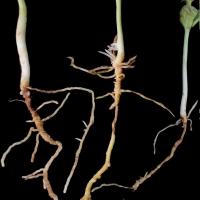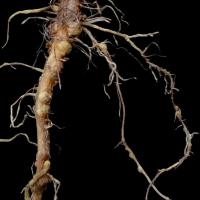Diagnosing pleiochaeta root rot in narrow-leafed lupins
Pleiochaeta root rot is caused by the fungus Pleiochaeta setosa , the same fungus that causes brown spot. It causes root rot but rarely causes major crop losses with reduced tillage and wider lupin rotations.
What to look for
- Wilted, weak or dying seedlings that can be scattered in the paddock, or vary in soil areas, and within or between seeding rows with variations in depth of pleiochaeta spores and seed.
- Disease incidence may be worse in paddocks with close lupin rotations, where the seeding operation places spores in the root zone.
- Deep burial of spores by mouldboard ploughing or spading will reduce disease severity.
Paddock
- Plants germinate normally. Severely affected seedlings wilt and die from dark-brown or black lesions on the taproot that can completely rot off the root.
- Less affected plants are weak and smaller than unaffected plants. Severe lesions strip off the outer layer of the taproot that prevents nodulation in this part of the root.
- After the 6-8 leaf stage the taproot thickens, and becomes less susceptible to infection. Lateral roots, however, are susceptible for longer periods and are often pruned-off.
Plant
What else could it be
| Condition | Similarities | Differences |
|---|---|---|
| Diagnosing Eradu patch in narrow-leafed lupins | Stripped taproots | Occurs in patches |
| Diagnosing rhizoctonia bare patch in grain legumes | Severed taproots | Occurs in patches |
| Diagnosing rhizoctonia hypocotyl rot in narrow-leafed lupins | Stunted and dying seedlings | Red brown hypocotyl lesion but no root lesions |
Where did it come from?

Contaminated soil
- Pleiochaeta infected leaves drop to the ground where the fungus produces spores.
- Spores remain dormant in the soil over summer and survive through non-lupin crops sown in the paddock (although their population declines over time).
- Cultivation and sowing incorporate the spores into the surface layer.
- When the next lupin crop is sown, spores germinate and infect the lupin roots causing pleiochaeta root rot.
- Rain splashes spores from the soil surface up onto leaves where they infect and cause brown spot, thus continuing the disease cycle.
- Disease severity is determined by the number of spores and their distribution in the soil. A high number of spores distributed close to the seed can cause severe disease.
Management strategies

Rotation

Seed dressing fungicide

Minimum tillage
- There is no treatment after sowing.
- Rotation with non-host crops (eg. cereals, canola, pasture) reduces the concentration of soil-borne spores.
- Fungicide seed treatments containing iprodione or procymidone (used to control brown spot) do not give consistent control of pleiochaeta root rot. However, partial control has occurred occasionally at high rates.
- Reduced or minimum tillage sowing operations reduce the incorporation of spores into the rooting zone of the soil profile.
- Deeper sowing places the emerging roots below the spore laden soil layer, this is particularly important with sowing systems utilising tillage systems.
- Reducing brown spot in preceding lupin crops can reduce the amount of spores returned to soil.
- Mouldboard ploughing and to a lesser extent spading can reduce disease by burying spores at depth.
See also
Where to go for expert help
Page last updated: Tuesday, 11 July 2017 - 10:14am





